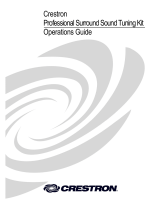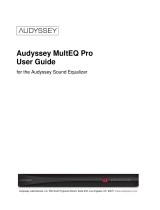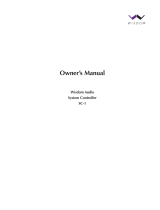Crestron Surround Sound Tuning Kit User guide
- Category
- Soundbar speakers
- Type
- User guide
This manual is also suitable for

Professional Surround Sound Tuning Kit
Quickstart guide
www.crestron.com
888.237.7876
©2010 Specifications subject to
change without notice.
201.767.3400
For details, check the latest version of the
Professional Surround Sound Tuning Kit Operations Guide, Doc. 6565.
QUICKSTART DOC. 6611D (2018783) 11.10
Professional Surround Sound Tuning Kit
Manufactured under license from Audyssey Laboratories. U.S. and foreign patents pending.
MultEQ XT is a trademark of Audyssey Laboratories.
NOTE: When Pro Sound Tools or PROCISE™ Tools is run for
the first time, a setup wizard will take you through the process.
Thereafter, the Configure button can be used to initiate the
process.
Insert the CD that came with the kit and click Add/Change Mic
Setup File. Select the file for the microphone that came with
your kit.
When a center speaker or subwoofer is not used, un-check the
Front Center Speaker and/or Subwoofer checkboxes.
Any subwoofer low-pass filter should be defeated or set to its
maximum frequency. Any subwoofer gain settings should be set
to their nominal or 12 o’clock position. Also, any sort of auto
standby or sleep mode for the subwoofer should be disabled.
Click Room Equalization Setup... to begin the process.
The “Job Information” screen is used to record the name of the
customer or job and the name of the technician performing the
job.
Click the forward arrow to proceed to the “Options” screen.
The “Options” screen is where you select the microphone file to
match the microphone you are using.
Select your microphone and click the forward arrow to proceed
to the “Measurement” screen.
2
Room EQ Setup
2
!
Hardware Hookup
1
Follow this check list to tune your system:
All components in the system should be powered off while
making connections.
Remove the plastic cover from the front of the processor.
Place the microphone stand upright.
Attach the microphone holder to the stand.
Insert the microphone in a vertical position in the holder.
NOTE: You must place the microphone in a vertical position with
the capsule facing the ceiling for all measurements.
Connect the mini female XLR end of the female mini XLR to
male XLR cable to the microphone.
NOTE: Use care when attaching the mini XLR cable so as not to
strain the connector.
For the AMS, connect the male XLR end of the cable to the XLR
end of the female XLR to stereo 3.5 mm cable. For the PSPHD,
connect the male XLR end of the cable to the XLR end of the
female XLR to mini XLR cable.
For the AMS, connect the stereo 3.5 mm plug to the microphone
input on the AMS. For the PSPHD, connect the mini XLR plug to
the microphone input on the PSPHD.
NOTE: Use care when attaching the microphone cable so as not
to strain the connector.
Using the included USB cable, connect your PC to the USB port
on the front of the processor.
!
!
!
Measurement
3
Quiet the room as much as possible.
Turn off phones, TVs, radios, air conditioners, etc. and close any
open windows.
Refrain from talking and do not sit or stand directly between any
of the speakers and the microphone.
NOTE: Do not touch the microphone stand or cable during the
measurement process.
Place the microphone at the primary listening location, at the ear
height of a listener seated at this location.
NOTE: It is important to have the microphone in the primary
listening position for the first measurement.
Press the Measure button. The Audyssey™ test signal will play
a series of 10 “chirps” through each channel.
A. Position 1 Measurement
B. Additional Position Measurements
Move the microphone to another listening position and press the
Measure button again. Repeat the process for all listening
positions in the room.
You will need to measure a minimum of three positions before
you can continue. The recommendation is to measure a
minimum of eight positions for typical rooms.
Click the forward arrow to finish the measurement process and
continue to the “Detection Results” screen, which displays the
results of the measurements.
Click the forward arrow to proceed to the “Target Sound Options”
screen.
!
!
Choose which of the Audyssey™ target curves you want to use
by selecting the radio button next to the curve:
For small to medium rooms (up to 2500 cu. ft.), choose the
High Frequency Roll Off 1 curve.
For medium to large rooms (up to 5000 cu. ft.), choose the
High Frequency Roll Off 2 curve.
For rooms larger than 5000 cu. ft., choose the SMPTE
202M curve.
The Midrange Compensation option (selected by default) is
used to adjust the balance between on-axis and reflected sound
in the crossover region. It is recommended that you leave this
box checked. You can return to this screen later and change
your setting if you prefer.
Click the forward arrow to calculate your correction curves and
proceed to the “Save Results” screen.
Target Sound Options
4
NOTE: It is important to use the Save Permanently to Crestron
function before leaving the program. Otherwise, all measurements will
be lost and you will have to start the process over from the beginning.
Audyssey Settings
6
!
NOTE: After completion, you can demonstrate the improved
performance of Audyssey™ Room Tuning from the AMS or
PSPHD front panel. On the AMS, go to the Audyssey
Configuration menu by selecting Theater, More, Tools and
Audyssey. On the PSPHD, press SETUP, then select Audyssey
MultEQ. This will allow an A/B comparison of the Audyssey and
non-Audyssey configurations. On the AMS, the system will
automatically default to the Audyssey configuration when this
menu is entered or exited. On the PSPHD, the last setting will take
priority.
!
Click Transfer to Crestron to temporarily store the filters so you
can listen to them. This process may take several minutes.
When MultEQ is On, use the Dynamic EQ On and Off buttons
to demo the Dynamic EQ function. The Dynamic Volume
presets can be auditioned as well.
Save Results
5
A. Transfer the MultEQ
®
XT Filters
B. MultEQ
®
Pro On/Off Demo
C. Dynamic EQ & Dynamic Volume On/Off Demos
You can now use the MultEQ On and Off buttons to demo
the MultEQ
®
XT filters.
Sometimes users want to change the level of the center channel
(for example, to boost dialog) or subwoofer. This is optional and is
not required most of the time but if it is desired, adjustments to
these or any other channels can be made by going into Pro Sound
Tools or PROCISE Tools and clicking on Speaker Adjustments.
This allows each speaker’s level to be adjusted individually.
Optional Adjustments
8
After saving the MultEQ
®
XT filters, the “Audyssey Settings” screen
is displayed. Use the sliders to adjust the amount of volume swing
for each of the preset values (Day, Evening, Midnight). After this is
complete, click the right arrow near the bottom of the screen.
Calibration Complete
7
Click the Save Permanently to Crestron button to save the
correction curves. This process may take several minutes.
D. Save the MultEQ
®
XT Filters
When the Calibration Complete message appears, click Close in
the lower right corner of the window to exit the application.
This step for
PSPHD only.
For AMS,
proceed to step D.
This step for
PSPHD only.
For AMS,
proceed to
section 7.
-
 1
1
Crestron Surround Sound Tuning Kit User guide
- Category
- Soundbar speakers
- Type
- User guide
- This manual is also suitable for
Ask a question and I''ll find the answer in the document
Finding information in a document is now easier with AI
Related papers
Other documents
-
 Crestron electronic Surround Sound Tuning Kit User manual
Crestron electronic Surround Sound Tuning Kit User manual
-
 Audyssey MultEQ Pro User manual
Audyssey MultEQ Pro User manual
-
 Wisdom Wands SC-1 User manual
Wisdom Wands SC-1 User manual
-
McIntosh MX100 Owner's manual
-
McIntosh MX123 Owner's manual
-
Denon AVC-A1HD User manual
-
ONKYO PR-SC5507 User manual
-
Integra DHC-80.1 Owner's manual
-
ONKYO PR-SC5509 User manual
-
Integra DHC-80.3 Owner's manual



